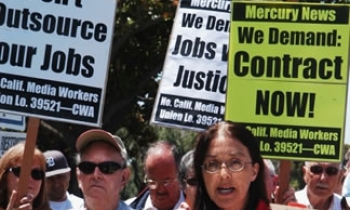NEW YORK: Public Editor Byron Calame of The New York Times explored the newspaper’s past coverage of New Orleans on Sunday in a column that slammed the paper for failing to report on the hurricane-ravaged city’s potential for disaster and growing poverty population.
In his seventh column since assuming the ombudsman-like role last spring, Calame said the Times should have done more in recent years to bring the Crescent City’s weakening levee problem to national attention and highlight the problems of low-income residents.
"The early coverage of the devastation of New Orleans revealed a depth of poverty and a troubled levee system that caught many by surprise. As a national newspaper with high aspirations, The New York Times assumes a responsibility to alert its readers to significant problems as they emerge in major cities such as New Orleans," the column placed inside the Week In Review section began. "Poverty so pervasive that it hampered evacuation would seem to have been worthy of The Times's attention before it emerged as a pivotal challenge two weeks ago. And the inadequacies of the levee system deserved to be brought to the attention of readers more clearly long before the storm hit.
"Yet a look back over the past 10 years of Times coverage of New Orleans in its news columns raises serious questions about how well the paper helped readers recognize and understand these two major problems that have compounded the devastation and tragedy of the storm," the column continued.
Calame went on to cite examples of previous Times reports on New Orleans, spanning both news and feature sections, which he contends did a poor job of giving a true picture of the city’s vulnerability.
"Indeed, over the past decade Times readers would have been hard-pressed to find a news headline about the poverty in the midst of the city that brings to the minds of many Americans the revelry of Mardi Gras and Bourbon Street. A search of substantive Times news articles about New Orleans since September 1995, conducted with the help of a researcher for the paper, found none that focused on the city's poor and the racial dimension of poverty. And there were only two articles about the city - both feature stories - that contained a few paragraphs on poverty and race," Calame wrote.
Calame cited a November 2000 feature article in the Weekend section that noted the city’s downtrodden, stating "Poverty persists, cheek by jowl with wealth, much of it inherited." The article also said, "A block or two from mansions with palm-shaded gardens stand crude unpainted bungalows fronting on crumbling streets, more reminiscent of the third world than dot-com America." But, Calame also wrote that "finding these words required reading to the 16th paragraph of the 3,700-word article."
He made the same comment about a 1996 Sunday magazine profile of New Orleans’ police superintendent, which "noted that more residents of New Orleans lived in poverty then than in any other large American city except Detroit. The article suggested that the ghettos of New Orleans have been ignored for decades because even though black politicians have controlled City Hall since 1978, African-Americans have never broken the white hold on economic power.’ But, Calame added, "these insights didn't come until the 12th paragraph of the 3,400-word article."
"What readers would have been more likely to find in The Times's past decade of news coverage of New Orleans were stylishly written articles about the city's charm, cuisine and colorful characters," Calame stated. "While some of those articles dealt with crime in the city's predominantly black neighborhoods, the issue of poverty was seldom explored in any depth."
Calame also pointed to a lack of reporting on the levees, which eventually led to the terrible flooding that has gripped the city. He reported finding just one "major article that focused on levees."
"The 2,100-word article on the front of the Science section in 2002 made clear that a Category 4 or 5 hurricane would send water over the top of the levees," the public editor revealed. "While the public editor's focus is on news coverage, there was also an Editorial Observer commentary in 2002 that took a detailed look at the problem, based on reporting in New Orleans. But neither the news article nor the editorial commentary prepared readers for the possibility of breaches in the levees or canal walls."
In conclusion, Calame gave the paper failing marks for its coverage, stating that, as a national newspaper, it needed to do more on the southern city’s needs.
"Given the dimensions of poverty in New Orleans and the city's dependence on a levee system, The Times's news coverage of these problems over the past decade falls far short of what its readers have a right to expect of a national newspaper."









